News Release
Tourism Satellite Accounts, Second Quarter 2006
REAL TOURISM OUTPUT GREW 1.4 PERCENT IN SECOND QUARTER 2006
Available for this release: Full Release (PDF) | Tables (XLS)
Growth in real tourism output slowed to an annual rate of 1.4 percent in the second quarter of 2006, according to data released today by the U.S. Bureau of Economic Analysis. In the first quarter of 2006, real tourism output grew 5.0 percent (revised). By comparison, real gross domestic product (GDP) grew at an annual rate of 2.9 percent in the second quarter of 2006, and 5.6 percent in the first quarter of 2006.
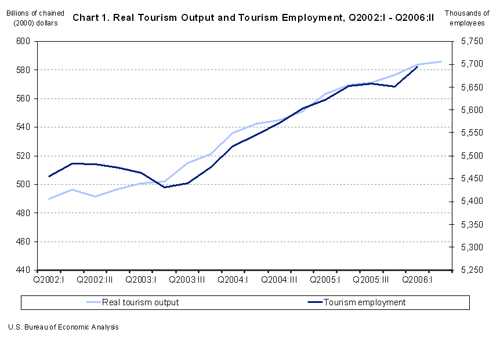
Tourism employment rose 3.1 percent in the first quarter of 2006, the largest quarterly increase in direct tourism employment in two years. By comparison, overall U.S. employment grew 1.7 percent in the first quarter of 2006.
Other highlights from this release of the travel and tourism satellite accounts include:
- Prices for tourism goods and services rose 7.4 percent in the second quarter of 2006, while the overall GDP price index
rose 3.3 percent in the second quarter. - Total current-dollar tourism-related output increased to $1.2 trillion in the second quarter of 2006.
- Total tourism-related employment accounted for 8.3 million jobs in the first quarter of 2006.
Changes in Real Tourism Output. Passenger air transportation posted a second consecutive quarter of strong growth, increasing 7.8 percent in the second quarter of 2006, following an increase of 9.3 percent in the first quarter (revised). In contrast, traveler accommodations experienced a fourth consecutive quarter of slower growth, with output actually declining 0.9 percent in the second quarter of 2006.
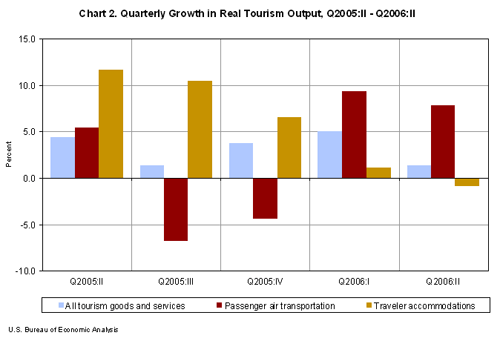
Changes in Tourism Prices. Prices for passenger air transportation grew 17.3 percent in the second quarter of 2006 – the fastest of all tourism commodities – due largely to higher fuel costs and reduced supply (fewer flights). In the first quarter of 2006, passenger air transportation prices declined 3.3 percent (revised). Prices for traveler accommodations rose an additional 3.4 percent in the second quarter of 2006, after having increased 7.8 percent (revised) in the first quarter.
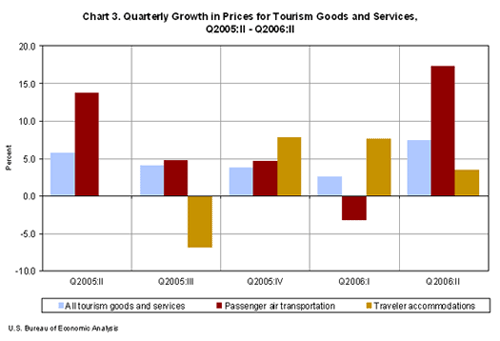
Changes in Tourism Employment. Although overall direct tourism employment rebounded strongly in the first quarter of 2006 (the latest period for which data are available), results across tourism industries were mixed. While the traveler accommodations industry added 5.1 thousand jobs, employment in the air transportation industry declined for the fifth consecutive quarter, a decrease of 2.7 thousand jobs.
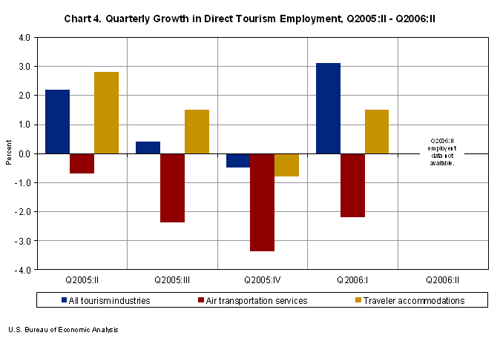
Total Tourism-Related Output. In the second quarter of 2006, total current-dollar tourism-related output of $1.2 trillion consisted of $661.4 billion of direct tourism output - output of goods and services sold directly to visitors, and $504.5 billion of indirect tourism-related output - output of goods and services used to produce what visitors buy.
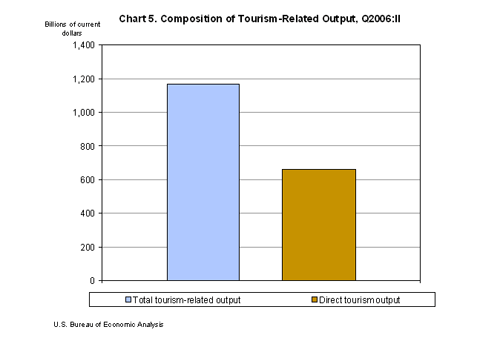
Total Tourism-Related Employment. In the first quarter of 2006 (the most recent period for which data are available), total tourism-related employment of 8.3 million consisted of 5.7 million direct tourism jobs - jobs where workers produce goods and services sold directly to visitors, and 2.6 million indirect tourism-related jobs - jobs where workers produce goods and services used to produce what visitors buy.
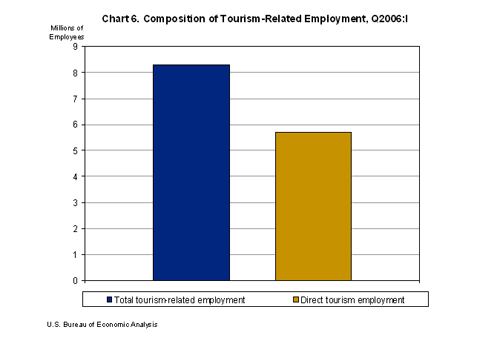
Definitions
Direct tourism output. Direct tourism output comprises all output consumed by visitors (e.g., traveler accommodations, passenger air transportation, souvenirs).
Indirect tourism-related output. Indirect tourism-related output comprises all output used as inputs in the process of producing direct tourism output (e.g., toiletries for hotel guests, the various ingredients used to make the meals served airline passengers, and the plastic used to produce souvenir key chains). Indirect tourism-related output is estimated using commodity-by-commodity output multipliers from the Current Industry Analysis Division.
Total tourism-related output. Total tourism-related output is the sum of direct tourism output and indirect tourism-related output.
Direct tourism employment. Direct tourism employment comprises all jobs where the workers are engaged in the production of direct tourism output (e.g., hotel staff, airline pilots, and souvenir sellers).
Indirect tourism-related employment. Indirect tourism-related employment comprises all jobs where the workers are engaged in the production of indirect tourism-related output (e.g., employees of companies that produce toiletries for hotel guests, the various ingredients used to make the meals served airline passengers, and the plastic used to produce souvenir key chains). Indirect tourism-related employment is estimated using industry-by-industry employment multipliers from the Regional Economic Analysis Division.
Total tourism-related employment. Total tourism-related employment is the sum of direct tourism employment and indirect tourism-related employment.
These estimates are from the Travel and Tourism Satellite Accounts (TTSAs), which are supported by funding from the Office of Travel and Tourism Industries, International Trade Administration, U.S. Department of Commerce. The current-price estimates of direct tourism output were derived from BEA's annual TTSAs (revised in June 2006) and current-dollar quarterly estimates of personal consumption expenditures from the NIPAs. The constant-price estimates of direct tourism output were developed using price indexes from the Bureau of Labor Statistics (BLS) and constant-price quarterly estimates of personal consumption expenditures from the NIPAs. The estimates of direct tourism employment were derived from the annual TTSAs (revised in June 2006) and the Quarterly Census of Employment and Wages from BLS. Employment data are available five to six months after the end of the reference quarter.
Quarterly estimates are expressed at seasonally adjusted annual rates, unless otherwise specified. Percent changes are calculated from unrounded data and annualized. "Real" estimates are in chained (2000) dollars. Price indexes are chain-type measures. Growth in overall U.S. employment is calculated using BLS Total nonfarm employment from Current Employment Statistics, http://www.bls.gov/ces/home.htm#data.
Next release – Travel and Tourism estimates for third quarter 2006 will be released on Thursday, December 14, 2006 at 8:30 a.m. EST.
BEA's national, international, regional, and industry estimates; the Survey of Current Business; and BEA news releases are available without charge on BEA's Web site at www.bea.gov. By visiting the site, you can also subscribe to receive free e-mail summaries of BEA releases and announcements.